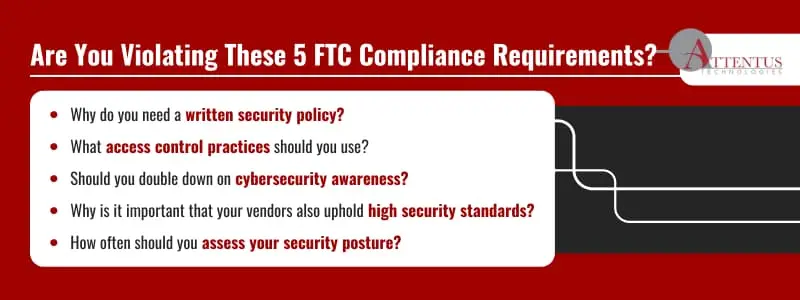Discover actionable steps to help your organization comply with the FTC Safeguards Rule.

On a scale of one to 10—with one being not at all and 10 being very—how confident are you about your Federal Trade Commission (FTC) compliance posture?
Do you know how the Safeguards Rule affects your business?
This regulation, established in 2003 and modified in 2021, sets the security standards financial institutions should adhere to when handling customer data.
Yet, despite being in effect for over two decades, misconceptions abound: Some small and medium-sized business owners aren’t aware they run a financial institution, for example.
And it’s not through any fault of their own — the FTC extends the definition of a “financial institution” beyond its traditional use to include companies handling substantial financial information or facilitating third-party financial transactions.
Others assume that simply having antivirus software or a firewall is enough.
These are essential building blocks, but a documented data protection plan (and more) is needed for compliance.
No matter what misconceptions you may hold, compliance is mandatory if your business falls under the FTC’s jurisdiction. Violations attract severe fines and even jail time. Plus, they can tarnish your good reputation and erode customer trust.
Are you willing to take the risk? Read on to learn the most common compliance pitfalls and practical steps to avoid them.
What Are the Most Common FTC Compliance Pitfalls?
1. Lack of a Written Security Plan
The FTC requires an up-to-date written information security program to comply with the Safeguards Rule.
Are you covered? Have you documented the administrative, technical, and physical measures you’ll use to ensure consistent data protection? Is the policy tailored to your business’s size and complexity?
More importantly, is it current?
Things can change drastically over just 12 to 18 months, you can significantly increase the risks to your business if you fall asleep at the wheel.
You need a written incident response plan to resolve potential eventualities quickly. Don’t wait to figure things out on the fly and risk non-compliance. Draft your security policy as soon as possible.
2. Weak Access Controls
Secure access is also key to FTC compliance. That leads us to a few important questions:
- What’s the status of your controls?
- How are you verifying access requests?
- Are you providing employees with too much access?
If you’re not using solid authentication mechanisms, what will stop threat actors from getting in? And if there is unrestricted access, aren’t you increasing your exposure to insider threats and the impact of an attack in case one of your employees’ accounts is compromised?
Implement multi-factor authentication (MFA) for anyone accessing customer data. Additionally, enforce the least-privilege principle: Give employees access to only what’s needed to perform their duties to mitigate against intentional misuse and unintentional exposure of data.
3. Inadequate Employee Training
Are your employees aware of what’s needed for security and compliance?
According to Cybernews, the human factor causes 95% of breaches and is the most prominent weak link in data protection. Many breaches happen because of clicking on the wrong things in email and website interactions.
If you don’t take the initiative to teach employees:
- How to spot phishing emails and other social engineering tactics.
- Best practices for password management.
- Procedures to follow in the event of a suspected security breach.
- Other compliance responsibilities and how they fit into the big picture.
Then, how will you mitigate the risks associated with the human factor?
4. Poor Vendor Management
When did you last evaluate whether your service providers’ security programs are in tip-top shape? Did you include your specific data protection requirements in contracts?
Gartner predicts that 45% of organizations will suffer a supply chain attack by the end of 2025. a service provider deeply integrated with your business processes or providing some essential components could introduce unnecessary risk if their security is not up to par. An attack on them could quickly trickle down to your organization.
That’s why the FTC Safeguards Rule emphasizes due diligence concerning third-party vendors.
- Include data protection requirements in your service level agreements (SLAs).
- Thoroughly evaluate your vendors’ security posture before forming a partnership.
- Regularly review their compliance status after onboarding.
The FTC also wants you to ensure continuous security so you’re always protected against threats.
5. Failure to Regularly Test Security Measures
The phrase “technology evolves rapidly” has become a bit overused at this point, but it rings more true than ever.
What was secure yesterday might not be today… or tomorrow.
If you take a “set and forget it” approach or rarely revisit security measures once implemented, won’t new vulnerabilities slip through the cracks?
The FTC doesn’t want you to wait to find out. It wants you to perform penetration testing annually, as well as system-wide scans biannually, to close gaps quickly.
If all this sounds daunting, partnering with a managed service provider (MSP) can take much of the burden off your shoulders.
Also: Do You Know How To Choose an MSP?
How Can an MSP Simplify FTC Compliance?
Compliance may seem daunting, but you don’t have to go it alone.
Your MSP will offer:
#1: Proactive Security Monitoring
Does stepping away from a reactive posture and embracing proactive security and compliance sound like a way to gain more peace of mind? A reliable MSP can help turn this aspiration into reality by delivering continuous monitoring, threat detection, and rapid incident response. That way, you have more control and insights to take action before any eventuality snowballs.
#2: Automated Compliance Reporting
You implemented FTC Safeguards Rule requirements. But can you prove compliance? An MSP helps ensure the answer is a resounding YES by automating compliance reporting and ensuring your documentation is always up-to-date and audit-ready.
#3: Data Encryption and Backup Solutions
Don’t know the best way to encrypt data at rest or on the go? Don’t stress. Your MSP can help you establish robust encryption protocols to protect data against unauthorized access in line with the Safeguards Rule.
It gets better.
They can help you implement a backup disaster recovery (BDR) strategy as an insurance policy against data loss. That way, you can quickly restore operations without missing a beat if an incident occurs.
#4: Customized Security Strategies
Your FTC compliance needs are unique. Why shouldn’t your strategy be as well? Working closely with an MSP to determine your specific operational requirements, budget constraints, and industry risks can help you more readily optimize security and compliance with a dynamic approach tailored to your business.
Ensure FTC Compliance and Financial Security With Attentus
As we wrap up, remember that effective cybersecurity isn’t just a compliance checkbox—it’s a strategic investment in your company’s future.
When you follow the Safeguards Rule, you’re making your business harder to crack, avoiding violation fines, and safeguarding data to maintain good standing with your customers. All of these are must-haves in an ultra-competitive landscape.
Attentus Technologies is here to simplify FTC Safeguards Rule compliance. Our proactive managed services—including comprehensive 24/7 monitoring, automated reporting, and tailored strategies—prevent common FTC compliance pitfalls, saving you time, money, and reputation.
Reach out to our team for a free consultation on how we can elevate your compliance posture.
